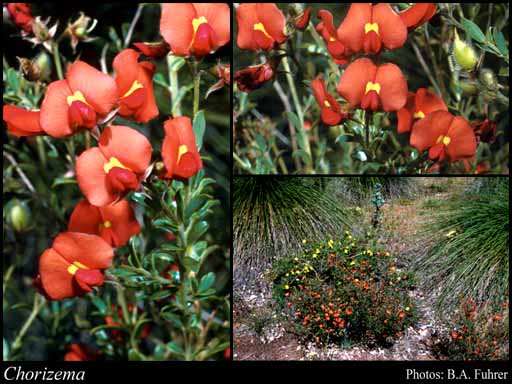- Reference
- Voy.Rech.Perouse 1:404, Pl. 21. (1800)
- Name Status
- Current

Scientific Description
Family Papilionaceae. Mirbelieae.
Sometimes included in Leguminosae.
Habit and leaf form. Shrubs (or undershrubs, sometimes prostrate), or lianas. Plants prickly, or unarmed. Leaves cauline. Plants with neither basal nor terminal concentrations of leaves. Self supporting, or climbing (occasionally); the climbers stem twiners, or scrambling. Leaves alternate (usually), or opposite to whorled; not decurrent on the stems; non-sheathing; simple; epulvinate. Leaf blades dorsiventral; entire, or dissected (sometimes, almost); flat, or folded, or rolled; cross-venulate (often), or without cross-venules. Leaves with stipules, or without stipules. Stipules when present, intrapetiolar; free of one another; small, setaceous. Leaf blade margins entire, or crenate, or serrate, or dentate; prickly (hollylike), or not prickly; flat, or revolute.
Reproductive type, pollination. Fertile flowers hermaphrodite. Unisexual flowers absent. Plants hermaphrodite. Entomophilous.
Inflorescence and flower features. Flowers aggregated in ‘inflorescences’; in racemes, or in fascicles. Inflorescences simple. The terminal inflorescence unit racemose. Inflorescences terminal (usually), or axillary (rarely). Flowers pedicellate; bracteate. Bracts persistent, or deciduous. Flowers bracteolate. Bracteoles small, persistent, or deciduous. Flowers very irregular; zygomorphic. The floral asymmetry involving the perianth, or involving the perianth and involving the androecium. Flowers papilionaceous; tetracyclic. Floral receptacle developing a gynophore, or with neither androphore nor gynophore. Free hypanthium present, or absent. Hypogynous disk present; intrastaminal; annular. Perianth with distinct calyx and corolla; 10; 2 -whorled; isomerous. Calyx present; 5; 1 -whorled; gamosepalous; five lobed. Calyx lobes markedly shorter than the tube, or about the same length as the tube. Calyx imbricate, or valvate; exceeded by the corolla; bilabiate (the two posterior lobes often broader and more connate), or regular; non-fleshy; persistent; non-accrescent; with the median member anterior. Corolla present; 5; 1 -whorled; appendiculate, or not appendiculate. Standard not appendaged. Corolla polypetalous, or partially gamopetalous. 2 of the petals joined (the keel members). The joined petals anterior. The wings of the corolla laterally spurred (auriculate), or not laterally spurred. Standard ‘normally’ developed; entire, or emarginate (usually). Keel conspicuously exceeded by the wings to about equalling the wings (straight or rarely incurved, obtuse or acuminate, the wings oblong and usually curved); not long-acuminate/beaked; neither coiled nor spiralled. Corolla imbricate; yellow, or orange, or red, or pink (or these in different combinations); deciduous; non-accrescent. Petals clawed. Androecial members definite in number. Androecium 10. Androecial sequence determinable, or not determinable. Androecial members free of the perianth; all equal, or markedly unequal; free of one another; 1 -whorled. Androecium exclusively of fertile stamens. Stamens 10; all more or less similar in shape, or distinctly dissimilar in shape; diplostemonous; both opposite and alternating with the corolla members; filantherous. Anthers separate from one another to connivent; all alike; dorsifixed, or basifixed; versatile, or non-versatile; dehiscing via longitudinal slits; latrorse, or introrse. Gynoecium 1 carpelled. The pistil 1 celled. Carpels reduced in number relative to the perianth. Gynoecium monomerous; of one carpel; superior. Carpel stylate. Style (in-) curved, or straight, or coiled (short or long). Style flattened, or terete. Style glabrous. Stigmatic tissue terminal, or oblique. Carpel (4–)8–32 ovuled. Placentation basal. Gynoecium median. Ovary sessile to stipitate. Stigmas capitate, or punctiform. Ovules funicled; biseriate; non-arillate (no ‘strophiole’).
Fruit and seed features. Fruit stipitate, or subsessile; non-fleshy; not spinose. The fruiting carpel dehiscent; a legume. Pods somewhat elongated, or much elongated (ovoid, obovate or elliptic); not triangular; straight; becoming inflated, or not becoming inflated; somewhat compressed, or terete; not constricted between the seeds; incompletely transversely septate between the seeds, or not transversely septate; wingless. Fruit 1 celled. Dispersal unit the seed. Seeds reniform; not mucous. Embryo bent (radicle inflexed). Testa non-operculate.
Geography, cytology, number of species. Native of Australia. Endemic to Australia. Australian states and territories: Western Australia, New South Wales, and Victoria. South-West Botanical Province. 2n = 16, 32. A genus of 25 species; 26 species in Western Australia; 14 endemic to Western Australia.